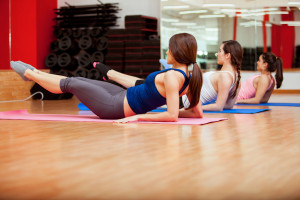 If you are a woman and have never had kids or if you are a man, you may have no idea what Diastasis or Diastasis Recti is. It’s not something that you often hear about in the fitness community unless you are a pregnant woman either pre-natal or post-natal. However, Diastasis can affect anyone. Diastasis Recti is a separating of the abdominals known as the Rectus Abdominis or what we know and see as the ‘six-pack’ muscles. The purpose of the abdominals, aside from looking good, is to support organs and back. That’s a pretty big deal when you really stop and think about it. When the Rectus separate your structure is less supported. In Pilates we sometimes refer to the abdominals as the ‘cage’. If there is a weakness in the cage, whatever is inside it is at risk. That’s your back and organs, people.
If you are a woman and have never had kids or if you are a man, you may have no idea what Diastasis or Diastasis Recti is. It’s not something that you often hear about in the fitness community unless you are a pregnant woman either pre-natal or post-natal. However, Diastasis can affect anyone. Diastasis Recti is a separating of the abdominals known as the Rectus Abdominis or what we know and see as the ‘six-pack’ muscles. The purpose of the abdominals, aside from looking good, is to support organs and back. That’s a pretty big deal when you really stop and think about it. When the Rectus separate your structure is less supported. In Pilates we sometimes refer to the abdominals as the ‘cage’. If there is a weakness in the cage, whatever is inside it is at risk. That’s your back and organs, people.
Generally most people think of the core as what we see on the surface. We see models with chiseled abs and think ‘that’s what I want’. But what is on the surface is just that. It looks pretty, but if there is no substance and strength underneath, then it’s just an illusion. What you really need to focus on and what can prevent or help you come back from Diastasis is a strong pelvic floor. The pelvic floor is the bottom of your cage. The Transverse is the deepest abdominal muscle that runs horizontally across your belly just above the pubic bone. When strong, it is the foundation of support for the organs and back. The Multifidi are the deep back muscles just above the sacrum and run vertically. Strong multifidi are another key component in supporting the organs and back. If you are just getting into an exercise program from a relatively sedentary lifestyle or if you are overweight, pre-or post natal, you are at the highest risk. Before you even think about doing your first ‘crunch’ you need to focus on building a strong pelvic floor by doing lower abdominal and lower back strengthening. If you were an architect, you wouldn’t install the roof before the floor and the walls, right? Think of your Rectus as your roof, if that helps you to visualize. If you already have Diastasis you can still build your pelvic floor to help support the weakening in the front. This will give the Rectus time to come back together at least somewhat, though you may always have some instability there. It depends on the severity of your separation. There is a simple at-home way to tell if you have Diastasis, but always get confirmation from your doctor.
-Lay flat on your back with your knees bent and legs together.
-Tuck your pelvis. Meaning tip your pelvis towards your face so that your back is completely flat on the floor.
-Lift only your head and upper shoulders off the floor. You can use one hand to support your neck if necessary.
-Place two fingers horizontally in your navel. If the space between the muscles is wider than that-three fingers or more, it is likely that you have Diastasis.
-Do this same test along the midline of your abdomen from just under the sternum (base of the ribcage) to right above the pubic bone.
1-2 fingers of space is a normal gap between the two sides of Recti.
At Home Strengthening Exercises:
Swimmer Leg Kicks (for the Multifidi)- Lay on your stomach with hands under your forehead and legs extended. Pull your ab muscles in and begin alternating leg lifts without shifting your hips side to side. Start slow and increase your pace as you get stronger.
Single Straight Leg Stretch– Lay on your back with your hands by your side and spine flat on the floor. Begin with both legs straight up to the ceiling. If you have tight hamstrings you can slightly bend your knees. Pull in your abs on your inhale and lower one leg to 45 degrees and then pull the leg back up with your exhale keeping the abs engaged. Switch legs and repeat 10-20 times. If you have lower back issues, place your hands under your bottom and/or lessen the degree you lower each leg.
Double Leg Lower Lift– Follow the same directions as the exercise above except the legs are pressed together and move as one unit. Be mindful of any movement in the spine. Your spine should remain flat into the floor or mat throughout the whole movement. If you feel any lift at all, you must reduce your range of motion until your pelvic floor and lower back become stronger.
Jessica Kuiken is a Los Angeles based Certified Pilates Instructor. You can follow her on Facebook and Twitter

















